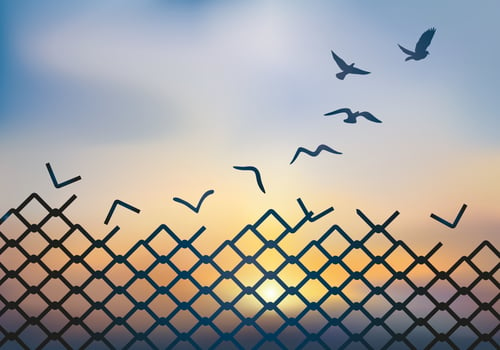Center for Justice & Economic Advancement
Normalizing Education Resource Center
How to Sow the Seeds of Postsecondary Success in Prison
By Will Anderson
Will Anderson, who is currently incarcerated in Minnesota Correctional Facility-Faribault, offers postsecondary leaders advice about overcoming challenges they may face when launching college programs in corrections facilities.
Learn more about the Center for Justice and Economic Advancement
When asked for the advice that I would offer to postsecondary leaders looking to launch college programs in prison, I went looking for a metaphor to describe the environment that such a program would need in order to take root, survive, and thrive inside a correctional facility. I ultimately concluded that current U.S. institutions of incarceration might best be described as degraded landscapes where invasive species flourish.
The forces currently thriving in and shaping this environment—from public presuppositions about people who are incarcerated to the punitive mindset that pervades our nation’s prisons and jails—have spawned a virulent ecosystem in what might otherwise be a healthy biome. In such inhospitable environments, the burgeoning college programs are themselves an invasive non-native species, and they must work furiously to adapt and survive.
Threat to the Carceral Status Quo
Life while incarcerated is reinforced to grow in one direction or another based on the sort of nurturing—or neglect—that happens in that specific environment. Part of what makes prison culture toxic for college students is that the environmental shifts necessary for students and college programs to thrive are shifts that threaten the vitality of the carceral status quo. The violence and exploitation that are common elements of prison culture perpetuate and endure by feeding off the lives of the students who pass through the environment. When the constructive activism of postsecondary education finds its way into a facility, the existing culture goes on notice. It knows that college programs and the students who participate in them are here to kill it. However, I’ve recently had conversations with current college students and recent graduates who push back on the assumption that negative cultural forces adversely impact all aspects of the lives of people who take college classes in prison. While violence is a real and persistent threat, they say peer relationships won’t have much, if anything, to do with an individual’s decision to pursue a college degree. A desire to participate and succeed in college is not automatically met with peer resistance. In fact, it’s often the opposite. Pursuit of a college degree is as legitimate a hustle as anything else someone might do to improve their circumstances in prison.
"I’ve recently had conversations with current college students and recent graduates who push back on the assumption that negative cultural forces adversely impact all aspects of the lives of people who take college classes in prison."
The challenges peers present are virtually no different than those that students who aren’t incarcerated face from their peers. At worst, my peers are having fun, staying up late, and getting high, and they aren’t as focused on their studies as I am. The true cultural confrontations invariably come from correctional facility staff and from entrenched attitudes toward incarcerated individuals.
These confrontations often surface outside the classroom and run the gauntlet of security staff. Often working-class individuals who are struggling in their own right, prison staffers can feel resentful of the opportunity to study that they see incarcerated students having. They might speak derisively to students or find reasons to pull them over and harass them through gratuitous pat-downs and searches. They might fail to provide necessary materials in time for class. Or lag times in communication may lead to information failing to arrive by deadlines that were supposed to be met with staff support.
Moreover, a facility’s pass and controlled movement systems—which students rely on to be able to attend class—may repeatedly fail. Or students may be (in)conveniently left off class attendance rosters.
Watch Out for Willful Dysfunction

Leaders of college programs should remain cognizant of these dynamics and watch for any repetition that begins to feel like willful rather than random dysfunction. It’s important to remember that the rules systems in carceral facilities are ostensibly designed for safety and security, but they also serve as a device for unfettered enforcement. Most operate like one big stop-and-frisk apparatus whereby facility staffers always have a convenient pretext for ruining the day, if not the life, of an individual on a whim. This self-reinforcing system often reacts violently to the presence of students and the faculty who partner with and support them.
In addition to the surface friction with facility staff, depending on the hierarchy and organizational structure in the facility, there also may be educational staff and administrators who push back in subtle or direct ways against the movement and opportunities that accompany the introduction of a campus culture into that facility. Knowing the role that any previous college programming played in the facility is an important first step for postsecondary leaders seeking to understand where and how new efforts might find fertile ground.
Directors of correctional education departments may feel territorial or frustrated by the elimination of corrections-led programs over which they had absolute control. And they may not fully appreciate the difference between offering a smattering of college-level courses and the more comprehensive cultural and philosophical shifts that college-led and federally-supported degree programs will be able to employ in order to improve academic and economic outcomes for students with records.
"While there are unquestionably good and decent people at every level of corrections, just as there are people who resist change based on their oppressive mindsets, there are many people whose actions are only as good as the system will allow them to be."
The philosophies and priorities of individual facility administrators add another layer of complication. They may be working at cross purposes with the current leaders in their state’s department of corrections and resist full implementation of students’ access to the resources they need for success.
While a facility’s administrators may not specifically intend to obstruct or inhibit a college program, in some cases the makeup of an administrative team is the inevitable result of generations of mass incarceration and punitive warehousing. Wardens, associate wardens, and correctional program directors (or their equivalents) aren’t hired fresh out of college. They’re typically promoted up through the ranks over decades of service in the proverbial trenches of the carceral state. If you consider the work environments where they cut their teeth and the professional experiences they had as they came of age, you’ll quickly recognize the extreme disconnect between the longstanding practices that are the norm in corrections facilities and the classroom practices that research tells us are necessary for student success.
It’s these individuals who control implementation of policy and access to infrastructure. Hierarchically positioned above the staff with whom students interact on a regular basis, they are the agents of accountability for the actions of those staff. Depending on their approach and inclination, they may apply either constructive or destructive pressure when it comes to determining how the day-to-day operations of a college program will proceed.
While there are unquestionably good and decent people at every level of corrections, just as there are people who resist change based on their oppressive mindsets, there are many people whose actions are only as good as the system will allow them to be. It is with all of these stakeholders in mind that one must carefully make conscious and deliberate choices to establish the relationships, partnerships, and practices necessary to successfully encourage the shift in culture that accompanies the introduction or expansion of a college program in a prison.
"Each semester is a new growing season, a new opportunity to cultivate the cultural change that will allow new and returning students to flourish while pursuing a college education."
Engage Students as Advisors
Making the effort to ensure that a college program can take root and thrive in the often hostile environment of a prison is a daunting undertaking, but successful initiatives can begin to transform the ecosystem and open up new pathways to education and economic advancement for people who are incarcerated. And each semester is a new growing season, a new opportunity to cultivate the cultural change that will allow new and returning students to flourish while pursuing a college education.
As you build a program, remember that your inaugural cohorts of students will be invaluable to establishing the resilient root system that will help the program grow and thrive despite the odds—and give future students increasingly effective opportunities to discover themselves and realize their potential.
When you find yourself working through the tensions and setbacks that will inevitably arise when you’re trying to create habitable space for college culture inside a correctional facility, remember that every ecosystem yearns to be healthy, that every seed planted brings value, and that despite the fact that malicious life forms have thrived in these environments for generations, you are walking amongst humans, and everywhere you step there is still fertile soil ready to produce new life.
Fertile Soil for a Resilient Root System
Making the effort to ensure that a college program can take root and thrive in the often hostile environment of a prison is a daunting undertaking, but successful initiatives can begin to transform the ecosystem and open up new pathways to education and economic advancement for people who are incarcerated. And each semester is a new growing season, a new opportunity to cultivate the cultural change that will allow new and returning students to flourish while pursuing a college education.
As you build a program, remember that your inaugural cohorts of students will be invaluable to establishing the resilient root system that will help the program grow and thrive despite the odds—and give future students increasingly effective opportunities to discover themselves and realize their potential.
When you find yourself working through the tensions and setbacks that will inevitably arise when you’re trying to create habitable space for college culture inside a correctional facility, remember that every ecosystem yearns to be healthy, that every seed planted brings value, and that despite the fact that malicious life forms have thrived in these environments for generations, you are walking amongst humans, and everywhere you step there is still fertile soil ready to produce new life.
Will Anderson (they/them) has participated in a wide variety of postsecondary education programs while incarcerated and was recently accepted into the PhD program in Comparative Studies in Discourse and Society at the University of Minnesota. They will begin the program while still incarcerated in the fall of 2024.
Learn more about the Center for Justice and Economic Advancement


